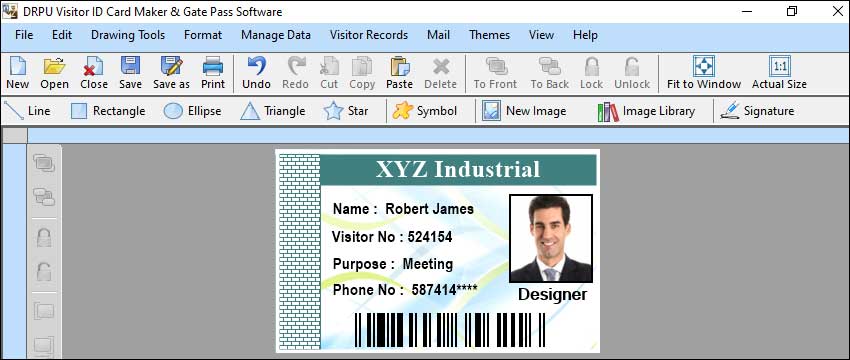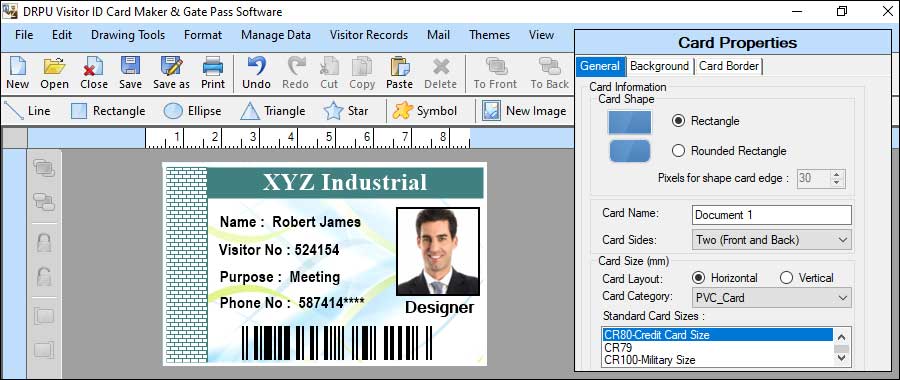Gate Pass Maker: Time Taken, Advantages and Design Customization
The Time Taken to Create a Gate Pass using a Gate Pass Maker
The time it takes to create a gate pass using a gate pass maker can vary depending on several factors, including the complexity of the gate pass, the efficiency of the software or process being used, and the number of gate passes that need to be generated. Here's a detailed breakdown of the factors that can impact the time required:

-
01 Gate Pass Design:
The initial setup time will depend on whether you are using pre-designed templates or creating a custom gate pass layout. If you are starting from scratch and designing a custom gate pass, it may take longer to set up the layout, fields, and any additional design elements. However, if you are using pre-designed templates, you can save time by selecting a suitable template that meets your requirements.
-
02 Information Input:
The time needed to create a gate pass also depends on the amount and accuracy of the information you need to input. If you have all the necessary information readily available, such as names, dates, and other details, the process will be faster. However, if you need to collect or verify information before creating the gate pass, it may add some additional time.
-
03 Data Import or Integration:
Gate pass makers with advanced features often allow for data import or integration with external systems, such as attendee lists, employee databases, or ticketing platforms. If you can import the required information directly into the gate pass maker, it can significantly reduce the time spent on data entry.
-
04 Customization and Validation:
The time required for customization and validation depends on the complexity of the gate pass maker and the level of customization you need. If you require additional fields, barcode/QR code generation, photo integration, or any other specific customization, it may take longer to set up and validate the gate pass design.
-
05 Printing and Distribution:
After creating the gate pass digitally, you will need to consider the time required for printing and distributing the passes. This includes factors such as printer speed, availability of printing resources, and the number of gate passes that need to be printed. If you are using a digital gate pass system that generates electronic passes, the printing and distribution step may be eliminated or reduced.
-
06 Familiarity with the Gate Pass Maker:
The time needed to create gate passes can be influenced by your familiarity and experience with the gate pass maker. If you are using the software or process for the first time, there may be a learning curve involved. However, as you become more proficient with the gate pass maker, the time required to create each pass should decrease.
-
07 Quantity:
The time required to create a single gate pass using a gate pass maker is relatively short. However, the overall time increases as the number of gate passes to be generated grows. For large events or organizations requiring a significant number of gate passes, it's essential to consider the time required to generate a batch of passes.
Note: It's important to note that while gate pass makers can streamline the process and save time compared to manual methods, the specific time required will vary based on the factors mentioned above. It's advisable to consider these factors and plan accordingly to ensure sufficient time is allocated for gate pass creation, especially when dealing with larger quantities or complex customization requirements.
Key Advantages of using a Gate Pass Maker
Using a gate pass maker, whether it is specialized software or a digital process, offers several benefits compared to manual gate pass creation. Here are some of the key advantages:
-
Efficiency and Time Savings:
Gate pass makers automate the process of creating gate passes, eliminating the need for manual data entry and paperwork. This saves time and increases overall efficiency, especially when dealing with a large number of gate passes. The software can generate passes quickly, reducing administrative burdens and allowing staff to focus on other important tasks.
-
Accuracy and Consistency:
Gate pass makers help minimize errors and ensure consistent information across all passes. The software can validate data entries, enforce mandatory fields, and prevent common mistakes. This reduces the risk of incorrect information being printed on gate passes, which can lead to access control issues or delays.
-
Customization and Flexibility:
Gate pass makers often offer customization options to meet specific requirements. You can tailor the design, layout, and fields according to your organization's needs. This allows you to include essential information, such as logos, visitor photos, event details, or access instructions. Customization ensures that the gate pass aligns with your branding and provides the necessary information to authorized personnel.
-
Security and Access Control:
Gate pass makers can enhance security by incorporating features such as barcode or QR code generation. These codes can be scanned at access points to validate the pass and grant entry. Additionally, gate pass makers may include features like access control system integration, enabling seamless integration with existing security infrastructure.
-
Record Keeping and Reporting:
Gate pass makers often include database storage or record-keeping capabilities. This allows you to maintain a digital record of all gate passes issued, including relevant details such as visitor names, entry/exit times, and purpose of visit. The software may also provide reporting features, enabling you to generate attendance reports, visitor logs, or other useful analytics.
-
Streamlined Visitor Management:
For organizations that frequently deal with visitors, gate pass makers can streamline visitor management processes. They allow for pre-registration of visitors, enabling faster check-ins and reducing waiting times. Gate pass makers can also send automated notifications to hosts, informing them of their visitors' arrival and ensuring a smooth visitor experience.
-
Cost Savings:
While gate pass makers may involve upfront costs for software or setup, they can lead to long-term cost savings. By eliminating manual processes, reducing errors, and enhancing efficiency, gate pass makers optimize resource utilization and minimize administrative overhead. The reduction in paper-based passes also contributes to cost savings and aligns with environmental sustainability goals.
Conclusion: Overall, using a gate pass maker improves operational efficiency, enhances security, ensures accuracy and consistency, and provides customization options tailored to specific needs. It streamlines gate pass creation and management processes, offering numerous benefits to organizations of all sizes and industries.
Customize the Design of a Gate Pass using a Gate Pass Maker
It is possible to customize the design of a gate pass using a gate pass maker, especially with specialized gate pass software. Gate pass makers often provide customization options to tailor the design and layout of the gate pass according to your specific requirements. Here's a detailed explanation of the customization possibilities:

-
Layout and Structure:
Gate pass makers typically offer flexibility in terms of the layout and structure of the gate pass. You can customize the placement of fields, labels, and any other relevant information on the pass. This allows you to design a gate pass that is intuitive, easy to read, and visually appealing.
-
Fonts and Typography:
Gate pass makers often provide options for font styles, sizes, and colors. You can choose fonts that are consistent with your organization's branding or align with your preferred aesthetic. This ensures visual consistency and enhances the readability of the gate pass.
-
Branding and Logos:
Gate pass makers allow you to incorporate your organization's branding elements into the design. This includes adding logos, company names, or specific color schemes that align with your brand identity. Customizing the gate pass with your branding elements helps reinforce your organization's image and professionalism.
-
Photo Integration:
Some gate pass makers allow for the inclusion of photos on the gate pass. This feature is particularly useful for identification purposes or when creating passes for events where personal identification is required. You can customize the size and placement of the photo on the pass to ensure clarity and visibility.
-
Backgrounds and Graphics:
Gate pass makers may offer the ability to include custom backgrounds or graphics on the gate pass. You can use this feature to add patterns, textures, or images that enhance the visual appeal of the pass. For example, you might incorporate security patterns, event themes, or facility images to add context or branding elements.
-
Field Customization:
Gate pass makers typically allow you to define and customize the fields present on the gate pass. You can add or remove fields as per your requirements. This enables you to include essential information such as attendee name, date, time, purpose of visit, access instructions, or any other specific details relevant to your organization or event.
-
Barcodes and QR Codes:
Gate pass makers often include the option to generate barcodes or QR codes on the pass. These codes can be scanned at access points for quick and accurate verification. You can customize the appearance and content of the barcode or QR code to include unique identifiers, ticket numbers, or other relevant information.
Note: It's important to note that the level of customization options available may vary depending on the gate pass maker and the software used. Some gate pass makers offer extensive customization capabilities, allowing you to create highly personalized and visually appealing gate passes. Others may have more limited customization options but still provide flexibility to modify certain aspects of the design.
Before selecting a gate pass maker, it's advisable to explore the customization features it offers and ensure they align with your desired design requirements.
👤 Tech Solution
📅
🕔 7 Minutes